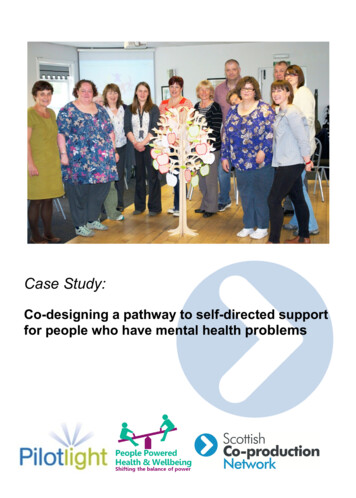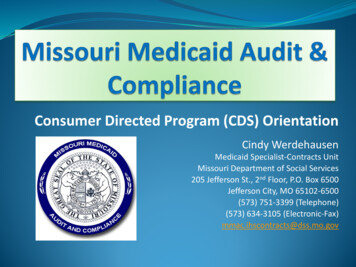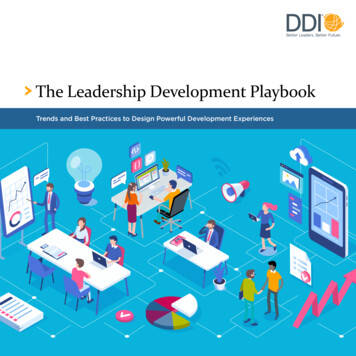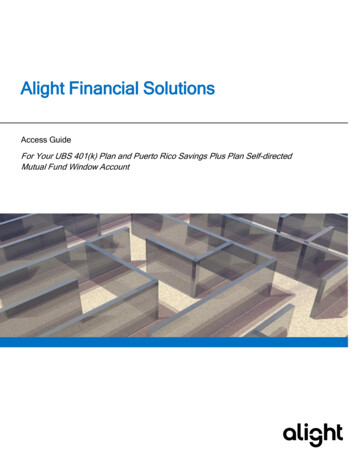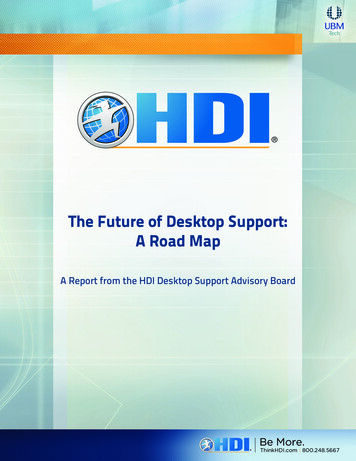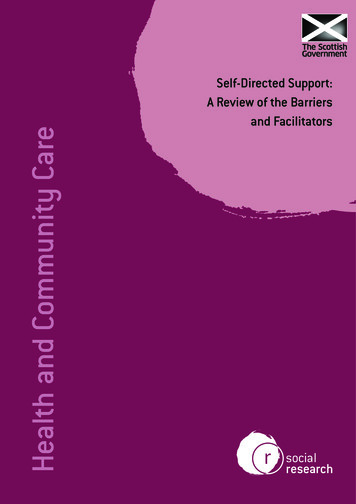
Transcription
Health and Community CareSelf-Directed Support:A Review of the Barriersand Facilitators
SELF-DIRECTED SUPPORT:A REVIEW OF THE BARRIERS AND FACILITATORSJill Manthorpe, Jessica Hindes, Stephen Martineau, MichelleCornes, Julie Ridley, Helen Spandler, Ann Rosengard,Susan Hunter, Simon Little and Bill GrayScottish Government Social Research20112
This report is available on the Scottish Government Social Research websiteonly www.scotland.gov.uk/socialresearch.The views expressed in this report are those of the researcher anddo not necessarily represent those of the Scottish Government orScottish Ministers. Crown Copyright 2011Limited extracts from the text may be produced provided the sourceis acknowledged. For more extensive reproduction, please contact theQueens Printers of Scotland, Admail, ADM 4058,Edinburgh EH1 1NG. Email: licensing@oqps.gov.uk
CONTENTS12345EXECUTIVE SUMMARY5Specific BarriersWhat helps Self-Directed Support?How this study was carried outNext Steps6889INTRODUCTION: DEFINING SELF-DIRECTED SUPPORT10Defining Self-Directed SupportPersonalisationDirect Payments (DPs)Cash and Counseling (American spelling)Individual/Personal BudgetsSelf-directed support (SDS)Other termsPersonal Assistance Services program (US)Individualised fundingCash for careIndividualized Quality of Life projectConsumer-directed careSummary and implications for lusion criteria for searchExclusion criteria for searchScreening procedureComments on research quality21212222BARRIERS23System wideSDS cannot be implemented successfully without an active local third sectorRelationships between SDS and other benefitsSDS interfaces with other parts of the public sector are unclearLack of choicePractitioner experiences and expectationsStaff are concerned about their jobs and roles in the light of SDSSDS may result in poor working conditions for directly employed staffSDS is a damaging and expensive move from block contractsService user and carer perspectivesThe administrative burden of SDS is too greatUsers (or carers) may not want the responsibility of managing their own money/servicesA number of studies point to challenges with the employment of Personal Assistants (PAs)Negative aspects over the employment of family membersUsers are unsure of expenditure limitsLegal and procedural frameworksManagement and leadership FACILITATORS34PolicyLeadershipUser and carer interestsProcesses and proceduresPractitioner perspectivesSummary3435373839393
6OVERALL SUMMARY417REFERENCES424
1 EXECUTIVE SUMMARY1.1This is a report on the published literature on the barriers and facilitators of selfdirected support. It was undertaken to inform a research study funded by theScottish Government 2009-2011 that is evaluating initiatives in three localauthorities. These initiatives aim to improve take up of self-directed support forpeople eligible for social care and other public funds. The three test site areasare working to reduce bureaucracy; to make the processes easy and ‘lighttouch’; and to provide training and leadership to people working on thesedevelopments. Scottish Government has provided extra money to assist thesethree authorities and to help people in other areas learn from their experiences.1.2This literature review asked what the barriers are to self-directed support andwhat helps it work (the facilitators) (how the literature was reviewed isdescribed at the end of this summary). By literature we mean research that hasbeen carried out on self-directed support to find out what works and for whom.Research is not extensive and so we also looked at other documents, such ascase studies, descriptions and commentaries.1.3Our definition of self-directed support was very wide; this is because it meansdifferent things to different people. We used it as an umbrella term to describea system of publicly funded social care and support that may involve othergovernment money. Being publicly funded by local authorities and other partsof government means that people have to be eligible for the funding and that insome instances they have to pay part or all of the cost, if their income andsavings are assessed as being enough to make this co-payment. Under thesystem of self-directed support, people are asked to think about what mattersto them. They can choose to spend the sum allocated to them in a way thatbest meets their needs and is under their control. In many ways it continues asystem that promotes choice and control that has been running for many years;Direct Payments. In England the new system is often called Personal Budgets,and sometimes Individual Budgets, but this may apply only to local authorityfunded social care. In Scotland a range of government funds are involved inthis development.1.4Overall the literature reveals: Much agreement about the barriers to the development of self-directedsupport.; and; Many suggestions and experiences about ways in which self-directed supportmay be facilitated.1.5However, much of the research relates to Direct Payments and there is verylittle evidence about other forms of deployment (the ways in which people canchoose to manage their money and the ways in which various funds worktogether).1.6Not surprisingly, we found that barriers and facilitators are sometimes linked –for example, lack of information is a barrier and good or accessible5
information appears to be a facilitator. Similarly, lack of legal clarity is abarrier, while clarity appears to assist users, carers and practitioners alike. Butother subjects are not so simple. We found that there were few easyconclusions to draw about the management of risk and cost-effectiveness.There are not simple trade-offs in these areas. Indeed, many studies tell uslittle about risks and fail to provide details of costs and outcomes or results.1.7We have very little evidence about the best ways to monitor self directedsupport but there are suggestions that ‘light touch’ monitoring may open uprisks at a number of levels as well as helping to reduce burdens ofadministration. These are matters for wider public debate in Scotland andbeyond, not least when money is tight. One limit of existing research for today’ssocial care is that it took place before the current recession.1.8There is wide agreement that reduced bureaucracy and less ‘red-tape’ arewelcome (unless there are concerns about abuse and exploitation) but howthese actually work is only touched upon by a few studies. Many studies andcommentaries find it hard to decide what is over- or under-protection and fewexpand on links with adult safeguarding.1.9Leadership may help with promoting changes in practice and in attitudes toself-directed support (as it does in any change); however, most commentariesand experiences focus on situations where self directed support is aninnovation rather than mainstream activity. We do not have much evidenceabout the ways to sustain changes, but many commentators note theimportance of service users and carers supporting each other. Training foralmost everyone is seen as valuable but there is not too much detail on whatskills are needed and how they can be developed; sometimes training may justdescribe giving information.1.10 Finally, the availability of transitional funding (temporary money to help startup a new system while still running the old system) is a helpful spur forinnovation but we generally have only the views of those people andorganisations that are likely to gain from this. There is little evidence about thelong-term effectiveness of self-directed support and its impact on other areas,parts of the system, or other groups of users that might have similarlywelcomed any or extra resources. All these comments support the importanceof a system wide approach to the rollout of self-directed support andunderstanding of its implications for Scottish citizens.Specific Barriers1.11 The research suggests that many of the barriers to the take up and use of selfdirected support are experienced by service users, carers, practitioners andother stakeholders. There is strong evidence that processes and systems havenot kept pace with the values incorporated under the umbrella term of selfdirected support. Some of the barriers may be resolved by governmentguidance which may reduce confusion and uncertainty.6
1.12 Within the research the following specific barriers were identified:System wide levels Self-directed support is publicised insufficiently. If the local third sector is not actively involved then practical and peer supportfor individuals may be insufficient. It is not always clear how self-directed support works with other parts of welfareor public services. It’s not easy to decide what are health or social care responsibilities and howself-directed support systems fit with other provision. Processes and procedures can seem under-developed leading to uncertainty.Practice and practitioner levels Staff are concerned about their jobs and roles in the light of self-directedsupport. Some fear self-directed support may worsen working conditions for social carestaff – especially care workers or families. They are concerned that self-directed support may be more expensive thanblock contracts (buying social care in bulk so that unit costs are less).Service user and carer levels Some feel the administrative burden of self-directed support is too great. Users (or carers) do not always want the responsibility of managing their ownmoney/services. Employment of Personal Assistants (PAs) is not always simple. Employment of family members may not be easy or best. Funding allocation systems and the rules on expenditure are not always clear tousers and carersLegal and procedural frameworks These may not be clear and lead to worries about accountability and blame Rules vary and change, leading to confusion7
Management and leadership levels These may not be sufficiently expert or experienced; they may have otherdemands on their time. What happens in a pilot may not be sustainable.What helps Self-Directed Support?1.13 The following facilitators were identified from the research:System wide levels Agreements over policy help clarify what is permitted and what the changes areintended to bring about. Realistic action plans help to translate aspirations into working practices. Clear implementation procedures provide assurances to staff about theiremployers’ aims.Practitioner perspectives Training and skills development are needed so that practitioners can be betterequipped to work with the new systems and to explain them to others. Staff too can benefit from sharing experiences, problems solving andinformation in networks.User and carer levels Information on self-directed support needs to be accessible and widelyavailable. Comprehensive support for users and carers can help when they are thinkingabout change and what might be needed over time. Social networks among users can help in sharing ideas and experiences. Being able to employ family members is welcome by some people. Brokers and advocates who are independent of the local authority can help withthe details and also in challenging the local authority. Plans to deal with possible emergencies are necessary.Management and Leadership Self-directed support champions or other inspiring people can help with start upand with addressing later problems. A steering group helps spread the load and enables messages about goodpractice and knowledge to reach everyone necessary.How this study was carried out1.14 This report is based on a systematic search of the research literatureexamining self-directed support in social care and factors that act as barriers orfacilitators to the up-take and development of self-directed support in the UnitedKingdom (UK). We broadened the scope of this study beyond self-directedsupport to include research in the area of personalisation (the term often usedin England). Several methods helped identify studies and contextual material,including the searching of key bibliographic databases, in August 2009 andupdated in August 2010. The search was primarily conducted using online8
research databases (Web of Knowledge, PubMed, Social CareAdditional searches were also carried out using relevant governmentthe Scottish Government and Department of Health) and third sector(such as In Control) for literature that may not be available ondatabases.Online).(such aswebsitesresearchNext Steps1.15 The next stage of the research is investigating what is happening in the threelocal sites in Scotland. This involves collecting data about take-up of selfdirected support and other local authority information. We are interviewingpeople using self-directed support and their carers, and working with managersand frontline staff in the local areas.9
2 INTRODUCTION: DEFINING SELF-DIRECTED SUPPORT2.1This study on the published literature on the barriers and facilitators of selfdirected support was undertaken to inform a research study funded by theScottish Government 2009-2011 that is evaluating initiatives in three localauthorities. These initiatives aim to improve take up of self-directed support forpeople eligible for social care and other public funds. The three test site areasare working to reduce bureaucracy; to make the processes easy and ‘lighttouch’; and to provide training and leadership to people working on thesedevelopments. Scottish Government has provided extra money to assist thesethree authorities and to help people in other areas learn from their experiences.2.2This chapter examines the use of the term self-directed support. Chapter 3describes the methodology employed in conducting the review of the publishedliterature. Chapters 4 and 5 report on the barriers and facilitators to SDSrespectively. The final chapter, Chapter 6 provides a summary of the findingsand reflects on these in relation to future development of SDS in Scotland.Defining Self-Directed Support2.3This review uses the term self-directed support (SDS) as an umbrella term.SDS is a subject that encompasses many concepts and practices in socialcare; sometimes these are used interchangeably; at other times they havedifferent meanings and cultural variations (1) (2). Many definitions anddescriptions of self directed support are unclear and rely on imprecise terms.One of the most common reference points to SDS is the concept ofpersonalisation, which has become widely used in England, but this is likewisea very broad term, generally using terms such as choice and controlinterchangeably and with little specificity. There are wide advantages to termsthat are ‘elastic’ in that they can be shaped to local circumstances and areadaptable to changing emphases. However, there are also disadvantages,such as imprecision, the risk of confusion, misunderstanding and geographicalvariations.2.4The Scottish Executiveof SDS:(3)has been using the following, widely cited, definitionDirect payments: 'A term used interchangeably with self directedsupport and appearing in legislation.The definition is historical andfocused on a system of delivery rather than the flexible independenceoutcomes that individuals can achieve when they choose and controltheir lives. Self directed support is for people who have been assessedas needing help from health and social care services, and who wouldlike to arrange for their own care and support instead of receiving themdirectly from the local authority. A person must be able to give theirconsent to be on self directed support and be able to manage it even ifthey need help to do this on a day-to-day basis.10
2.5More recently, the Scottish Governmentin its National Strategy for SDS:(4)has employed this definition Self-Directed Support (SDS) is a term that describes the ways inwhich individuals and families can have informed choice aboutthe way support is provided to them. It includes a range ofoptions for exercising those choices. Through a co-productionapproach to agreeing individual outcomes, options are consideredfor ways in which available resources can be used so people canhave greater levels of control over how their support needs are met,and by whom. (Emphasis in the original) In terms of current take-up, in Scotland 3,678 people received SelfDirected Support (Direct Payments) in the year 2009/10. This was anincrease of 661 (22%) from the 2008/09 level.(5)2.6It is important to note that the requirement that individuals must demonstratecapacity to consent has been superseded by a change of Regulations inEngland. In particular, new arrangements for proxy decision-making nowenable other people (such as carers) to consent to and manage social carepublic funding on behalf of users of social care services but the difficultiesencountered by carers of people with dementia in Scotland in accessing DirectPayments suggest that there are other barriers to making care morepersonalised as this report illustrates.(6) In Scotland this area is partiallycovered by the Adults with Incapacity (Scotland) Act 2000, Community Care(Direct Payments) (Scotland) Regulations 2003, in relation to parental consentfor young disabled people. The Scottish Executive Guidance on SDS (3) alsorefers to supported decision making, through user controlled trusts, circles ofsupport and advocacy.2.7Both within Scotland and beyond, there are attempts to clarify the field.(2) (7) Arecent definition from the Scottish group Changing Lives (8) definespersonalisation very broadly, and does not confine it to social care or to adults;it reads that personalisation:. enables the individual alone, or in groups, to find the right solutionsfor them and to participate in the delivery of a service. From being arecipient of services, citizens can become actively involved in selectingand shaping the services they receive. (p1)2.8In light of the importance of clarifying terminology, the section below describesthe various definitions or meanings ascribed to certain key terms.Personalisation2.9This phrase is often accompanied by the term ‘agenda’, meaning that it isgovernment policy or an overarching policy theme; for example:11
The government is working hard on its personalisation agenda,setting an ambition that all service users have control over thesupport they need.(9)2.10 From the viewpoint of a Commission set up by an English local authority toexplore what this might mean more precisely, a definition emerged thata ‘personalised’ adult social care system emphasises theindividual’s dignity, right to self‐determination, choice, control andpower over the support services they receive (p7) (10)2.11 There are also attempts to define personalisation by its antithesis or opposite:'The new model of personalisation is much more than ‘direct payments plus’.At the heart of the model are the three concepts of user control, choice ofservice and flexibility of support' (p9),(11) although this is not universally agreed.More often there are broad aspirations for what personalisation should be: apersonalised system is one 'which is fair, accessible and responsive to theindividual needs of those who use services and their carers' and one whereusers should be able to live independently, exercise control over their own lifeand to participate as active and equal citizens in community life (p2).(12) In suchdefinitions, the aims are instrumental and personalisation is 'a means ofoffering greater choice, empowerment and freedom' (p19).(13)2.12 As will be described below, in turning to the specifics, 'personalisation meansputting people at the heart of the design and delivery of services, giving themmore choice in how they live their lives and better access to services.Developing individual budgets for service users is at the heart of this'.(14) Herewe begin to encounter definitions of personalisation that are focused on socialcare services in the public sector: 'The aim of the personalisation of social careis to ensure that everyone who is eligible for social care support has morechoice and control over what that support is, how that support is delivered andby whom' (p6).(15) In terms of how such messages are being interpreted, thereis some evidence that although personalisation is a broad concept, socialworkers generally interpret it in terms of specific initiatives: direct payments(DPs), individual budgets (IBs), and so on.(16)2.13 It is not surprising therefore that there are now efforts to refine definitions: Personalisation is, quite simply, the design and delivery of publicservices in accordance with the identified needs and declaredrequirements of each individual rather than the commissioning ofservices perceived to meet the assumed needs of members ofpredetermined groups. (p2)(17)2.14 This has also revived the political dimension of the definitions: Personalisation is a political term being used to describe theintended transformation of relationships between government,service providers and service users in social care. (p9)(18)12
Direct Payments (DPs)2.15 In essence, these are cash payments provided instead of traditional services(19)and are: a means where disabled people can buy in the help and assistancethey need for their everyday needs and support help disabledpeople do things for themselves instead of relying on servicesdirectly from the Local Authority social services. (p3)(20)2.16 Policy-makers in England outlined the rationale for DPs as being 'to giverecipients control over their own life by providing an alternative to social careservices provided by a local council' (p3)(21). This is a similar basis to policy inScotland. It is important to note that Direct Payments (DPs) are not part of thebenefits system but are set within publicly funded social care services; 'thepayments that are made to individuals who have been assessed as needingsocial care services in order that they can make their own arrangements tomeet their needs' (p1).(22)2.17 DPs rest on a legislative base: ‘The Community Care (Direct Payments) Act1996, which came into force in April 1997, gave local authorities the power tooffer a direct cash payment in lieu of services to adults assessed as needingcommunity care services and new sections 12B and 12C were inserted into theSocial Work (Scotland) Act 1968’ (p4) (23) and section 13 amended. The optionof offering DPs was at first restricted to people aged 18-65 years. However,since July 2000 in Scotland (February 2000 in England) this power wasextended to include disabled people aged 65 and over, and expanded in 2001to include young disabled people between the ages of 16 -18 years. Since June2003 in Scotland (April 2003 in England), local authorities are obliged to offerDPs to all those eligible. Not surprisingly, research generally uses a shorterdefinition of DPs as ‘user-controlled purchasing of social care’ (p97).(24)2.18 However, some researchers and activists have emphasised that there is adistinction between a DP and a Third Party scheme.(23) In a third party scheme,payments are not made directly to the disabled person but to an agency oranother person. Some researchers only use the term DP in circumstanceswhere, ‘the money must be paid by the local authority direct to the disabledperson.’ (p4). In a few instances, the definition used in a research study notesthe potential for cash payments to be made to a third party or ‘indirectpayments’: Direct payments is a form of welfare whereby cash payments aremade directly to the individual to purchase the services they areassessed as requiring The term ‘direct payments’ [in this study]is being used generically to cover all cash payments made toindividuals to purchase services, whether these are made through athird party or not. (pp75-77) (25)2.19 The literature reveals many different uses of these terms. For example, as theparagraph above notes, sometimes DPs are described as being predominantly13
made directly to the user, generally with a specific service in mind. Otherdescriptions use terms such as Individual Budgets (IBs) when talking about atransparent allocation of resources (telling people what they are entitled to interms of the money allocated to them), which may bring together funding fromseveral sources.(26) However, some of the definitions offered are not widelyshared in the literature and need to be carefully examined. For example, thereare reports that some policy makers see DPs as funding from the LA socialcare budget; self-directed support as funding from multiple streams; and IBs asbeing like SDS but placed in a single bank account to deliver seamlesssupport.(27) There is a great need for care over these complicated definitions.2.20 Despite this, there is wide agreement that DPs enable service users topurchase their own support (28) (29) (30) , although there are sometimes unspokenassertions that the sums provided under DPs are directly equivalent to thecosts of LA funded services. In other words, there is not much discussion ofways in which some DPs may be less than the total sum awarded becausevarious ‘on costs’ are taken out of them before the money reaches the enduser: Direct payments are a means by which people can be given controlover the resources that would otherwise have been used to pay forservices to be provided to them. (p19)(31)2.21 In essence, these definitions suggest that DPs are an alternative fundingmechanism, sufficient to meet social care needs: Direct payments are a means by which people who require socialcare directly receive community care monies so that they canchoose and pay for their own support to meet their needs.(32)2.22 There are further implicit suggestions in other studies that once a person hasbeen provided with a DP then they are not likely to call on other local authoritysocial care services: in these definitions users are described as having ‘controlover money spent on meeting their community care needs, rather thanreceiving services arranged for them by the local authority' (p459).(33)2.23 Furthermore, some definitions focus on what can be purchased under themechanism of DPs; one study noted that the system running described itself asoffering cash payments designed to purchase 'personal assistance': 'Thepayments can be used to pay an agency to provide the support the individualwants, as well as to directly employ personal assistants to enable the person tolive the way they want.' (p644).(34) Goods and equipment might have been hardto fund under this system but these were seen as completely acceptable in theIB pilots.(35) (36)2.24 Interestingly, few definitions refer to the potential in England (but not Scotland)for carers to receive DPs. Stuart is one of the few that adds carers to users inhis definition of DPs:14
More people than ever before can now choose to have cashpayments to purchase their own personal assistance rather thanusing services arranged for them by local authorities. This schemeis called ‘direct payments’ There are two key components todirect payments. The first is the care manager’s assessment of theneeds of service users and carers The second component is thesupport services that will help users and carers manage their directpayments. (pVIII)(37)2.25 Lastly, there are definitions that focus on matters in common between termssuch as DPs and SDS rather than defining difference.(38)Cash and Counseling (American spelling)2.26 Research has generally noted that DPs are found in other developed countriesbut with different terminology. The United States (US) experience is widelyreported (in the US) and the research there has been longitudinal, in-depth andmultidimensional. The term used in most US studies is ‘Cash and Counseling’,which is defined as the provision of: a flexible monthly allowance that consumers can use to hire theirchoice of workers (including relatives) and purchase other servicesand goods that meet their personal assistance needs Cash andCounseling also provides counseling and fiscal assistance to helpconsumers plan and manage their responsibilities and allows themto designate representatives (such as family members) to makedecisions on their behalf. (p2)(39)2.27 The similarities between Cash and Counseling and DPs are considerable asCash and Counseling is described as 'offering elders and younger persons withdisabilities a cash allowance in place of agency-delivered services' (p812),(40)although the nature of the information services provided differentiate these fromUK schemes. 'The Cash and Counseling model offers a cash allowance andinformation services to clients so they can purchase personal care services,assistive devices, or home modifications that best meet their individual needs.'(p646).(41), (42) In contrast to the UK, there has been early development of 'Cashand Counseling schemes for all age groups (it) gives frail elders and adultsand children with disabilities the option to manage a flexible budget and decidefor themselves what mix of goods and services will best meet their personalcare needs.' (p1).(43)Individual/Personal Budgets2.28 Turning to the UK, and in particular, England, individual budgets (IBs) emergedearly on as a term that virtually summed up the meaning of personalisation inadult social care. Many researchers have relied on the Department of Health’sdefinition or ‘product branding’ of IBs: [they] bring together various existing funding streams (community carepurchasing budgets, community equipment budgets, Supporting People15
funding, Disabled Facilities grants, Independent Living Fund, Access toWork) in order to permit social care users to construct care packages tosuit their needs and provide them with the outcomes that they [want].(p18)(44)2.29 Definitions mention that this blending of funding streams theoretically enablesIB ‘holders’ to fund other forms of support than through employment of supportworkers: ‘IBs are a form of individualised funding (IF). In an
self-directed support systems fit with other provision. Processes and procedures can seem under-developed leading to uncertainty. Practice and practitioner levels Staff are concerned about their jobs and roles in the light of self-directed support. Some fear self-directed support may worsen working conditions for social care

